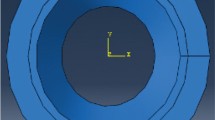The existing stress distribution model of casing-cement-formation mostly does not fix the far-field displacement boundary in model building, and the disturbance of formation displacement at infinity caused by the well construction process can not be eliminated, which is not completely in line with reality. Taking the strata stress as the stress boundary and initial stress field condition, and fixing the farfield displacement boundary of the formation, a modified model of casing-cement-formation combination for directional well is derived with the undetermined coefficients method. On the basis, the sensitivity analysis of the mechanical failure law of the wellbore integrity was carried out, and the calculation results showed that, as the elastic modulus of the formation and sheath decreases, the radial and circumferential compressive stresses on the casing and the cement sheath increase. The Poisson’s ratio of the cement sheath has little effect on the stress state of the casing and the cement sheath. The radial and circumferential compressive stresses on the casing and the cement sheath increase as the Poisson’s ratio of the cement sheath increases. When the pressure inside the casing is high, as the elastic modulus of the cement sheath increases, the tendency of the tensile circumferential stress at the cement sheath increases, and the compressive stress on the casing decreases. The traditional model overestimates the stress distribution of combination and the shear failure risk of the cement, but underestimates the tensile failure risk of the cement. For a vertical well on site in Bohai Bay, the mechanical property of the cement sheath at the 9-5/8” casing were evaluated, and the on-site cement slurry is reasonably used to meet the mechanical requirements of wellbore integrity. This paper can provide a theoretical basis for reasonably choosing cementing slurry formula.











Similar content being viewed by others
References
Wang Xianglin, Huang Yichun, Niu Lijun et al. A Research on Preventing and Resisting the Oil Permeation in Well Cementation[J].Acta Petrolei Sinica, 1999, 20(4):88-92.
Chen Zhixiong.Analysis of Influences of Casing Pressure Testing on Acoustic Amplitude Logging after Cementing[J]. Petroleum Drilling Techniques, 2003,31(3):36-37.
Vazquez G., A.M. Blanco, A.M. Colina. A Methodology to Evaluate the Gas Migration in Cement Slurries.SPE Latin American and Caribbean Petroleum Engineering Conference,Society of Petroleum Engineers,Rio de Janeiro, Brazil,2005.
Krusche K., C.R. Johnson, N.Y. Braud, et al. Application of Engineered Cementing Solution To Solve Long-Term Cement Integrity Issues in Tunisia.SPE Annual Technical Conference and Exhibition,Society of Petroleum Engineers,San,Antonio,Texas, 2006.
Thiercelin M., B. Dargaud, J. Baret, et al. Cement design based on cement mechanical response.SPE annual technical conference and exhibition,Society of Petroleum Engineers, San,Antonio,Texas,1997.
Thiercelin M., C. Baumgarte, D. Guillot. A Soil Mechanics Approach To Predict Cement Sheath Behavior.SPE/ISRM Rock Mechanics in Petroleum Engineering, Society of Petroleum Engineers, trondheim norway, 1998:329-337.
Rogers M.J., R.L. Dillenbeck, R.N. Eid. Transition time of cement slurries, definitions and misconceptions, related to annular fluid migration. SPE Annual Technical Conference and Exhibition, Society of Petroleum Engineers, Houston, Texas, 2004.
Ravi K., M. Bosma, O. Gastebled. Safe and economic gas wells through cement design for life of the well. SPE Gas Technology Symposium,Society of Petroleum Engineers, Calgary, Alberta, Canada, 2002.
Gray K.E., E. Podnos, E. Becker. Finite-element studies of near-wellbore region during cementing operations: Part I.SPE drilling & completion, 2009, 24(1):127-136.
WangW., A.D.Taleghani. Three-dimensional analysis of cement sheath integrity around Wellbores.Journal of Petroleum Science and Engineering, 2014, 121(2014):38-51.
Deng Jin-gen, Wang Kang-ping, Huang Rong-zun, Chen Mian. Collapse resistance of oil well casing-cement mantle combi -nation subjected to non-uniform loading by rock creep[J]. Chinese Journal of Rock Mechanics and Engineering, 1994, 13(2):160-167.
Fang Jun, Song Yufeng. Analysis of loading property of casing and cement sheath under non -uniform geologic stress[J]. Journal of China University of Petroleum : Edition of Natural Science,1995, 19(6) : 52-57.
Chen Zhaowei,Yin Youquan. Theoretical study on effect of cement sheath on casing load[J]. Acta Petrolei Sinica, 2007, 28(3):141-144.
Lu Yafeng, Zheng Youzhi, She Chaoyi, et al. Analysis of cement-sheath mechanical integrity based on the experiment data of cement paste[J].Natural Gas Industry, 013, 33(005):77-81.
Liu Hailong, Deng Jingen, et al. Study on cement sheath integrity for deviated wells [J]. Science Technology and Engineering, 2015, 15(1):202-205.
Shi Yucai, Guan Zhichuan, Xi Chuanming, et al. An analytical method for the calculation of allowable internal casing pressure based on the cement sheath integrity analysis[J]. Natural Gas Industry, 2017, 037(007):89-93.
Shen Jiyun, Shi Lin, Li Yong, et al. Analysis and perspective of cement sheath integrity under a high differential pressure[J]. Natural Gas Industry, 2017, 037(004):98-108.
Guo Xinyang, Bu Yuhuan, Li Juan, Li Qiang. Modes and prevention of cement sheath failures under complex downhole condition. [J].Natural Gas Industry, 2013, 33(011):86-91.
Liu Yang, Yan Haibing, Yu Xin, et al. Negative impacts of borehole pressure change on cement sheath sealing integrity and countermeasures. [J] Natural Gas Industry, 2014, 34(4):95-98.
Wei Liu, Baohua Yu, Jingen Deng. Analytical method for evaluating stress field in casing-cement-formation system of oil/gas wells[J]. Applied Mathematics & Mechanics, 2017.
Author information
Authors and Affiliations
Corresponding author
Additional information
Translated from Khimiya i Tekhnologiya Topliv i Masel, No. 2, pp. 104–109 March– April, 2023
Rights and permissions
Springer Nature or its licensor (e.g. a society or other partner) holds exclusive rights to this article under a publishing agreement with the author(s) or other rightsholder(s); author self-archiving of the accepted manuscript version of this article is solely governed by the terms of such publishing agreement and applicable law.
About this article
Cite this article
Yu, G., Xu, J., Liu, W. et al. A Modified Model of Cement Sheath Stress Distribution with a Fixed Far-Field Displacement Boundary Condition. Chem Technol Fuels Oils 59, 362–374 (2023). https://doi.org/10.1007/s10553-023-01536-2
Published:
Issue Date:
DOI: https://doi.org/10.1007/s10553-023-01536-2




